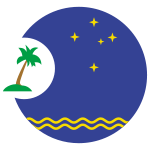Wallis and Futuna
Wallis and Futuna, officially the Territory of the Wallis and Futuna Islands[3] (/ˈwɒlɪs ... fuːˈtuːnə/; French: Wallis-et-Futuna [walis.e.futuna] or Territoire des îles Wallis-et-Futuna, Fakauvea and Fakafutuna: 'Uvea mo Futuna), is a French island collectivity in the South Pacific between Tuvalu to the northwest, Fiji to the southwest, Tonga to the southeast, Samoa to the east, and Tokelau to the northeast.
Wallis and Futuna | |
|---|---|
Overseas collectivity of France | |
| Territory of the Wallis and Futuna Islands Territoire des îles Wallis-et-Futuna (French) Telituale o 'Uvea mo Futuna (Wallisian and Futunan) | |
 Flag  Unofficial coat of arms | |
| Motto(s): | |
| Anthem: "La Marseillaise" | |
.svg.png) Location of Wallis and Futuna | |
| Sovereign state | France |
| Protectorate over Wallis | 5 April 1887 |
| Protectorate over Alo and Sigave | 16 February 1888 |
| Separation from New Caledonia | 1961 |
| Current status | 2003 |
| Capital and largest city | Matā'Utu 13°17′S 176°11′W |
| Official languages | French |
| Common languages |
|
| Demonym(s) |
|
| Government | Devolved parliamentary dependency |
| Emmanuel Macron | |
• Administrator Superior | Thierry Queffelec |
• Assembly President | Atoloto Kolokilagi |
• King of Uvea | Patalione Kanimoa |
• King of Alo | Filipo Katoa |
• King of Sigave | Eufenio Takala |
| Legislature | Territorial Assembly |
| Area | |
• Total | 142.42 km2 (54.99 sq mi) |
• Water (%) | negligible |
| Population | |
| 11,558 | |
• Density | 83.55/km2 (216.4/sq mi) (125th) |
| GDP (nominal) | 2005 estimate |
• Total | $188 million[2] |
• Per capita | $12,640[2] |
| HDI (2008) | 0.793 high |
| Currency | CFP franc (XPF) |
| Time zone | UTC+12:00 |
| Driving side | right |
| Calling code | +681 |
| ISO 3166 code |
|
| Internet TLD | .wf |
Its land area is 142.42 km2 (54.99 sq mi) with a population of 11,558 at the 2018 census (down from 14,944 at the 2003 census).[1][4] Matā'Utu is the capital and biggest city. The territory is made up of three main volcanic tropical islands along with a number of tiny islets, and is split into two island groups that lie about 260 km (160 mi) apart, namely the Wallis Islands ('Uvea) in the northeast, and the Hoorn Islands (also known as the Futuna Islands) in the southwest, including Futuna Island proper and the mostly uninhabited Alofi Island.
Since 2003, Wallis and Futuna has been a French overseas collectivity (collectivité d'outre-mer, or COM). Between 1961 and 2003, it had the status of a French overseas territory (territoire d'outre-mer, or TOM), though its official name did not change when the status changed.
History
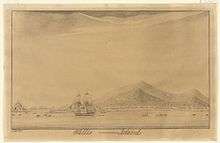

Early humans
The earliest signs of human habitation in these islands are from the Lapita culture, dating to around 850 to 800 BCE. The islands served as natural stopover points for boat traffic going between Fiji and Samoa. During the Tongan invasions of the 15th and 16th centuries, the islands showed varying levels of resistance and assimilation, with Futuna retaining more of their pre-Tongan cultural features while Wallis underwent more fundamental changes in society, language and culture.[5] The original inhabitants built forts and other identifiable ruins on the islands, some of which are still partially intact. Oral history and archaeological evidence suggest that the Tongan invaders reoccupied and modified some of these structures. Oral history also preserves a cultural memory of long-standing relationships between Samoa and Futuna going back to the islanders' origin stories.[5]
European settlements
Futuna was first put on the European maps by Willem Schouten and Jacob Le Maire during their circumnavigation of the globe in 1616. They named the islands "Hoornse Eylanden" after the Dutch town of Hoorn where they hailed from. This was later translated into French as "Isles de Horne." The Wallis Islands are named after the British explorer Samuel Wallis, who sailed past them in 1767 after discovering Tahiti.[6][7] The French were the first Europeans to settle in the territory, with the arrival of French missionaries in 1837, who converted the population to Roman Catholicism. Pierre Chanel, canonized as a saint in 1954, is a major patron of the island of Futuna and the region.
On 5 April 1842, the missionaries asked for the protection of France after the rebellion of a part of the local population. On 5 April 1887, the Queen of Uvea (on the island of Wallis) signed a treaty officially establishing a French protectorate. The kings of Sigave and Alo on the islands of Futuna and Alofi also signed a treaty establishing a French protectorate on 16 February 1888. The islands were at that time put under the authority of the French colony of New Caledonia.
In 1917, the three traditional kingdoms were annexed to France and turned into the Colony of Wallis and Futuna, which was still under the authority of the Colony of New Caledonia.
World War Two
During World War II, the islands' administration was pro-Vichy until a Free French corvette from New Caledonia deposed the regime on 26 May 1942. Units of the US Marine Corps landed on Wallis on 29 May 1942.[8]
Overseas Territory
In 1959, the inhabitants of the islands voted to become a French overseas territory, effective in 1961, thus ending their subordination to New Caledonia.[9]
In 2005, the 50th King of Uvea, Tomasi Kulimoetoke II, faced being deposed after giving sanctuary to his grandson who was convicted of manslaughter. The King claimed his grandson should be judged by tribal law rather than by the French penal system. There were riots in the streets involving the King's supporters, who were victorious over attempts to replace the King. Two years later, Tomasi Kulimoetoke died on 7 May 2007. The state was in a six-month period of mourning. During this period, mentioning a successor was forbidden.[10] On 25 July 2008, Kapiliele Faupala was installed as King despite protests from some of the royal clans. He was deposed in 2014. There were no kings installed for two years. Finally, a new king, Patalione Kanimoa, was installed on Wallis in 2016; Filipo Katoa in Alo on Futuna succeeded after Petelo Sea had abdicated, and Eufenio Takala succeeded Polikalepo Kolivai in Sigave, The French president, François Hollande, was present.
Politics

The territory is divided into three traditional kingdoms (royaumes coutumiers): Uvea, on the island of Wallis, Sigave, on the western part of the island of Futuna, and Alo, on the eastern part of the island of Futuna and on the uninhabited island of Alofi (only Uvea is further subdivided, into three districts):
| Kingdom District | Capital | Area (km²) | Population 2003 census | Population 2018 census | 2003-2018 evolution | Villages(1) |
|---|---|---|---|---|---|---|
| Wallis Island | ||||||
| Uvea (Wallis) | Matāʻutu | 77.5 | 10,071 | 8,333 | -17.3% | 21 |
| Hihifo ("west") | Vaitupu | 23.4 | 2,422 | 1,942 | -19.8% | 5 |
| Hahake ("east") | Matāʻutu | 27.8 | 3,950 | 3,415 | -13.5% | 6 |
| Mu'a ("first") | Mala'efo'ou (2) | 26.3 | 3,699 | 2,976 | -19.5% | 10 |
| Futuna(3) | ||||||
| Sigave (Singave) | Leava | 16.75 | 1,880 | 1,275 | -32.2% | 6 |
| Alo | Mala'e | 47.5 | 2,993 | 1,950 | -34.8% | 9 |
| Total Futuna | Leava | 64.25 | 4,873 | 3,225 | -33.8% | 15 |
| Overall total | Matāʻutu | 142.42 | 14,944 | 11,558 | -22.7% | 36 |
- (1) referred to the villages with municipal status
- (2) formerly called Mua
- (3) Alofi is virtually uninhabited; administratively it falls under Alo
The capital of the collectivity is Matāʻutu on the island of Uvéa, the most populous of the Wallis Islands. As an overseas collectivity of France, it is governed under the French constitution of 28 September 1958, and has universal suffrage for those over 18 years of age. The French president is elected by popular vote for a five-year term; the high administrator is appointed by the French president on the advice of the French Ministry of the Interior; the presidents of the Territorial Government and the Territorial Assembly are elected by the members of the assembly.
The head of state is President Emmanuel Macron of France as represented by the Administrator-Superior Thierry Queffelec.[11] The President of the Territorial Assembly is Petelo Hanisi since 11 December 2013.[12] The Council of the Territory consists of three kings (monarchs of the three pre-colonial kingdoms) and three members appointed by the high administrator on the advice of the Territorial Assembly.
The legislative branch consists of the unicameral Territorial Assembly or Assemblée territoriale of 20 seats; the members are elected by popular vote to serve five-year terms. Wallis and Futuna elect one senator to the French Senate and one deputy to the French National Assembly.
Justice is generally administered under French law by a tribunal of the first instance in Mata-Utu, but the three traditional kingdoms administer justice according to customary law (only for non-criminal cases). The Court of Appeal is in Nouméa, New Caledonia.
The territory participates in the Franc Zone, and as a permanent member of the Secretariat of the Pacific Community and as an observer of the Pacific Islands Forum.
Geography


Wallis and Futuna is located about two-thirds of the way from Hawaii to New Zealand, at 13°18′S 176°12′W, (225 mi west of Samoa and 300 mi (480 km) north-east of Fiji).
The territory includes the island of Uvéa (the most populous), the island of Futuna, the essentially uninhabited island of Alofi, and 20 uninhabited islets, totaling 274 square kilometres (106 sq mi) with 129 kilometres (80 mi) of coastline. The highest point in the territory is Mont Puke (on the island of Futuna) at 524 metres (1,719 ft).
The islands have a hot, rainy season from November to April with associated storms caused by the passage of tropical cyclones over the islands. There is a cool, dry season from May to October caused by the predominance of the south-east trade winds during this time. Average annual rainfall is 2,500 to 3,000 millimetres (98–118 in) with rainfall likely on at least 260 days each year. The average humidity is 80% and the average temperature is 26.6 °C (79.9 °F), rarely falling below 24.0 °C (75.2 °F) and ranging between 28.0 °C (82.4 °F) and 32.0 °C (89.6 °F) during the rainy season.
Only five percent of the islands' land area is arable land; permanent crops cover another 20%. Deforestation (only small portions of the original forests remain), largely as a result of the continued use of wood as the main fuel source, is a serious problem; as a consequence of cutting down the forests, the mountainous terrain of Futuna is particularly prone to erosion. There are no permanent settlements on Alofi because of the lack of natural freshwater resources.
Islands
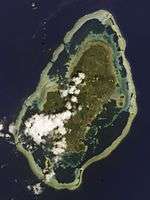
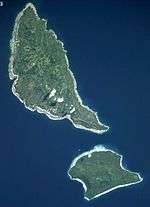
| Island | Capital | Other Cities | Area (km²) | Population[13] |
|---|---|---|---|---|
| Wallis and Futuna | Mata-Utu | Leava, Vaitupu, Alele, Liku, Falaleu, Utufua | 142.42 | 11,558 |
| Hoorn Islands (Futuna and Alofi islands) | Leava | Fiua, Nuku, Taoa, Mala'e, Ono, Vele | 64.1 | 3,225 |
| Alofi | 17.8 | 1 | ||
| Futuna | Leava | Toloke, Fiua, Vaisei, Nuku, Taoa, Mala'e, Kolopelu, Ono, Kolia, Vele, Kolotai, Laloua, Poi, Tamana, Tuatafa, Tavai | 46.3 | 3,225 |
| Faioa | 0.68 | 0 | ||
| Fenuafo'ou | 0.03 | 0 | ||
| Fugalei | 0.18 | 0 | ||
| Ilot St. Christophe | Chappel St. Christophe | 0.03 | 0 | |
| Luaniva | 0.18 | 0 | ||
| Nukuatea | 0.74 | 0 | ||
| Nukufotu | 0.04 | 0 | ||
| Nukuhifala | Nukuhifala | 0.067 | 4 | |
| Nukuhione | 0.02 | 0 | ||
| Nukuloa | Nukuloa | 0.35 | 10 | |
| Nukutapu | 0.05 | 0 | ||
| Nukuteatea | 0.1 | 0 | ||
| Other | Nukuato | 0.043 | 0 | |
| Tekaviki | 0.01 | 0 | ||
| Wallis (island) | Mata-Utu | Vaitupu, Alele, Liku, Falaleu, Utufua, Mala'efo'ou, Mala'e | 75.8 | 8,333 |
| Other | 0 | 0 | ||
| Wallis and Futuna | Mata-Utu | Leava, Vaitupu, Alele, Liku, Falaleu, Utufua | 142.42 | 11,558 |
Flora and fauna
Economy
The GDP of Wallis and Futuna in 2005 was 188 million US dollars at market exchange rates.[2] The territory's economy is limited to traditional subsistence agriculture, with about 80% of the labor force earning its livelihood from agriculture (coconuts and vegetables), livestock (mostly pigs), and fishing. About 4% of the population is employed in government. Revenues come from French government subsidies, licensing of fishing rights to Japan and South Korea, import taxes, and remittances from expatriate workers in New Caledonia, French Polynesia and France. Industries include copra, handicrafts, fishing, and lumber. Agricultural products include coconuts, bread fruit, yams, taro, bananas, pigs, and fish. In 1991, BNP Nouvelle-Calédonie, a subsidiary of BNP Paribas, established a subsidiary, Banque de Wallis-et-Futuna, which currently is the only bank in the territory. Two years earlier Banque Indosuez had closed the branch at Mata-Utu that it had opened in 1977, leaving the territory without any bank. Many exports include copra, chemicals, and fish.
Demographics
Population
.jpg)
The total population of the territory at the July 2018 census was 11,558 (72.1% on the island of Wallis, 27.9% on the island of Futuna),[1] down from 14,944 at the July 2003 census.[4] The vast majority of the population are of Polynesian ethnicity, with a small minority of Metropolitan French descent and/or native-born whites of French descent.
Lack of economic opportunities has since the 1950s pushed many young Wallisians and Futunians to migrate to the more prosperous French territory of New Caledonia, where, as French citizens, they can legally settle and work. More recently (since the middle of the 2000s), political tensions on the main island of Wallis (Uvea), due to a feud between rival aristocratic clans who are supporting competing kings, has led to a new surge of emigration towards New Caledonia and even the very distant Metropolitan France. At the 2014 New Caledonian census, 21,926 residents of New Caledonia (both born in New Caledonia and in Wallis and Futuna) self-reported their ethnicity as Wallisian and Futunian, which is almost double the total population of Wallis and Futuna.[14]
Historical population
| 1969 | 1976 | 1983 | 1990 | 1996 | 2003 | 2008 | 2013 | 2018 | ||||
|---|---|---|---|---|---|---|---|---|---|---|---|---|
| 8,546 | 9,192 | 12,408 | 13,705 | 14,166 | 14,944 | 13,484 | 12,197 | 11,558 | ||||
| Official figures from past censuses.[4][15] | ||||||||||||
Languages
At the 2018 census, among the population whose age was 14 and older, 59.1% of people reported that the language they spoke the most at home was Wallisian (down from 60.2% at the 2008 census), 27.9% reported Futunan (down from 29.9% in 2008), and 12.7% reported French (up from 9.7% in 2008).[16][17] On Wallis Island, the languages most spoken at home were Wallisian (82.2%, down from 86.1% in 2008), French (15.6%, up from 12.1% in 2008), and Futunan (1.9%, up from 1.5% in 2008).[16][17] On Futuna, the languages most spoken at home were Futunan (94.5%, down from 94.9% in 2008), French (5.3%, up from 4.2% in 2008), and Wallisian (0.2%, down from 0.8% in 2008).[16][17]
At the same 2008 census, 88.5% of people whose age was 14 or older reported that they could speak, read and write either Wallisian or Futunan, whereas 7.2% reported that they had no knowledge of either Wallisian or Futunan.[18] 78.2% of people whose age was 14 or older reported that they could speak, read and write French, whereas 17.3% reported that they had no knowledge of French.[18] On Wallis Island, 81.1% of people whose age was 14 or older reported that they could speak, read and write French, whereas 14.3% reported that they had no knowledge of French.[18] On Futuna, 71.6% of people whose age was 14 or older reported that they could speak, read and write French, whereas 24.3% reported that they had no knowledge of French.[18]
Religion
_drone.png)
The overwhelming majority (99%) of the people in Wallis and Futuna are Roman Catholics,[19] served by their own Roman Catholic Diocese of Wallis and Futuna, with see at Mata-Utu, a suffragan of the Metropolitan Archdiocese of Nouméa (New Caledonia).
Culture
The culture of Wallis and Futuna is Polynesian, and is very similar to the cultures of its neighbouring nations Samoa and Tonga. The Wallisian and Futunan cultures share very similar components in language, dance, cuisine and modes of celebration.
Fishing and agriculture are the traditional occupations and most people live in traditional fale houses in an oval shape made of thatch.[20] Kava, as with many Polynesian islands, is a popular beverage brewed in the two islands, and is a traditional offering in rituals.[20] Highly detailed tapa cloth art is a specialty of Wallis and Futuna.[21]
Transport and communications
In 1994, the territory had 1,125 telephones in use, had one AM radio station, and two television broadcast stations. Communication costs are high, costing up to ten times as much as western countries. The island of Wallis has about 100 kilometres (62 mi) of roadways, of which 16 are paved, while the island of Futuna has only 20 kilometres (12 mi), none are paved. The territory has two main ports and harbours, Mata-Utu and Leava (on the island of Futuna), that support its merchant marine fleet consisting of three ships (two passenger ships and a petroleum tanker), totaling 92,060 GRT or 45,881 tonnes. There are two airports, Hihifo Airport on Wallis with a paved runway of 2.1 kilometres (1.3 mi), and Pointe Vele Airport on Futuna with a 1 kilometre (0.62 mi) smaller runway.[22] New Caledonia-based Aircalin operates the only commercial flights that go to Wallis, where it has an office in Mata-Utu. There are currently no commercial boat operators.
Education
There are 18 primary schools in the territory with a combined total of over 5,200 students; 12 primary schools are on Wallis and six are on Futuna.[23]
The territory has six junior high schools and one senior high school/sixth-form college.[24]
- Junior high schools (collèges) in Wallis: Mataotama de Malae, Alofivai de Lano, Vaimoana de Lavegahau, and Tinemui de Teesi
- Junior high schools in Futuna: Fiua de Sigave and Sisia d'Ono
- The senior high school/sixth-form college is Lycée d'État de Wallis et Futuna on Wallis
There is also an agricultural high school.[23]
Healthcare
As of 2018, yaws was endemic in the area, but cases were not being reported to the WHO eradication programme.[25]
Health care is available without charge in two hospitals on Uvea and Futuna islands.[26] There are also three dispensaries.[27]
Environment
Deforestation is a major concern in the region as only small portions of the original forests remain due to the continued use of wood as the main source of fuel. Consequently, the mountainous terrain of Futuna has become prone to erosion. There are no permanent settlements on Alofi due to the lack of natural freshwater resources and the presence of infertile soil on the islands of Uvea and Futuna further reduces the agricultural productivity.[28]
Miscellaneous
The territory's data code and country code (top level Internet domain) is .wf.
See also
- Outline of Wallis and Futuna
- Administrative divisions of France
- French overseas departments and territories
- Islands controlled by France in the Indian and Pacific oceans
- Vicariate Apostolic of Oriental Oceania
References
- INSEE. "Les populations légales de Wallis et Futuna en 2018". Retrieved 7 April 2019.
- INSEE, CEROM. "L'économie de Wallis-et-Futuna en 2005: Une économie traditionnelle et administrée" (PDF) (in French). Archived from the original (PDF) on 9 September 2008. Retrieved 1 July 2008.
- Loi no 61-814 du 29 juillet 1961 conférant aux îles Wallis-et-Futuna le statut de territoire d'outre-mer (in French).
- INSEE. "Wallis et Futuna a perdu près du cinquième de sa population en dix ans" (in French). Retrieved 7 April 2019.
- Sand, Christophe (2006). "A View from the West: Samoa in the Culture History of `Uvea (Wallis) and Futuna (Western Polynesia)". The Journal of Sāmoa Studies. 2: 5–15.
- "POP Culture: Wallis and Futuna". Guampedia. Retrieved 3 March 2017.
- Chisholm, Hugh, ed. (1911). . Encyclopædia Britannica. 28 (11th ed.). Cambridge University Press. p. 285.
- p.213 Rottman, Gordon L. U.S. Marine Corps World War II Order of Battle: Ground and Air Units in the Pacific War, 1939-1945 Greenwood Publishing Group, 2002
- "Wallis and Futuna Islands". InfoPlease. Retrieved 14 April 2018.
- BBC News (1 June 2007). "Been and gone – fit for a King". Retrieved 3 June 2007.
- "France appoints new prefect of Wallis and Futuna". Radio New Zealand. Retrieved 27 January 2019.
- Wallis and Futuna Rulers.org
- "Population municipale des villages des îles Wallis et Futuna (recensement 2018)". INSEE. Retrieved 21 February 2020.
- ISEE. "L'évolution de la population par communauté d'appartenance". Retrieved 7 April 2019.
- INSEE. "Wallis et Futuna - Recensement de la population". Retrieved 7 April 2019.
- STSEE. "Les premiers résultats du recensement de la population 2018 - Principaux_tableaux_population_2018" (ODS) (in French). Retrieved 7 April 2019.
- INSEE, Government of France. "Tableau Pop_06_1 : Population selon le sexe, la connaissance du français et l'âge décennal" (in French). Archived from the original (XLS) on 7 April 2019. Retrieved 3 October 2009.
- INSEE, Government of France. "Tableau Pop_06_1 : Population selon le sexe, la connaissance du français et l'âge décennal" (XLS) (in French). Retrieved 3 October 2009.
- "The World Factbook — Central Intelligence Agency". www.cia.gov. Retrieved 14 April 2018.
- Ibpus.com; International Business Publications, USA (1 January 2012). Wallis & Futuna Business Law Handbook: Strategic Information and Laws. Int'l Business Publications. pp. 37–. ISBN 978-1-4387-7141-0. Retrieved 9 May 2013.
- Hinz, Earl R.; Howard, Jim (2006). Landfalls of Paradise: Cruising Guide to the Pacific Islands. University of Hawaii Press. pp. 220–. ISBN 978-0-8248-3037-3.
- Dominik Maximilián Ramík (26 May 2009). "Futuna - přílet z Wallisu - Flying to Futuna Island (from Wallis)". Retrieved 14 April 2018 – via YouTube.
- "LIVRET D'ACCUEIL Wallis et Futuna." Wallis and Futuna. p. 22 (22/28). Retrieved on 14 September 2016.
- "Cartographie des établissements du second degré." Wallis and Futuna. 24 June 2016. Retrieved on 14 September 2016.
- Fitzpatrick, Christopher; Asiedu, Kingsley; Solomon, Anthony W.; Mitja, Oriol; Marks, Michael; Van der Stuyft, Patrick; Meheus, Filip (4 December 2018). "Prioritizing surveillance activities for certification of yaws eradication based on a review and model of historical case reporting". PLoS Neglected Tropical Diseases. 12 (12). doi:10.1371/journal.pntd.0006953. ISSN 1935-2727. PMID 30513075.
- "Wallis and Futuna - Economy". Encyclopedia Britannica.
- "Travel Tips for Wallis and Futuna (France), Updated Intl. Guide – Travel Medicine, Inc". www.travmed.com.
- "The World Factbook". Central Intelligence Agency.
External links
| Look up Wallis and Futuna in Wiktionary, the free dictionary. |
| Wikimedia Commons has media related to Wallis and Futuna. |
| Wikivoyage has a travel guide for Wallis and Futuna. |

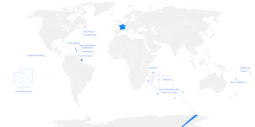
.svg.png)
